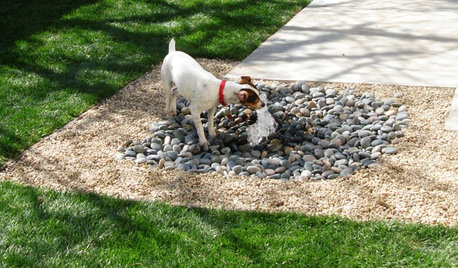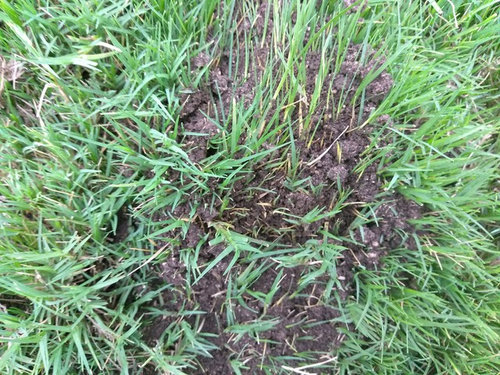control fire ants in backyard?
super dad
5 years ago
Featured Answer
Sort by:Oldest
Comments (33)
krnuttle
5 years agoTXSkeeter
5 years agoRelated Discussions
Aeration and fire ant control
Comments (9)I used beneficial nematodes for ant control and hundreds of other types of bugs. Spraying molasses will drive ants to your next door neighbors. It probably works very well since ant mounds are always small and never seem to last long while my neighbors would have huge ant mounds and are there for a long time if done nothing. Do you have any grass at all? What did you do after you had done core aerating? It should be ONE TIME ONLY... core aerating followed by compost then keep up with quarterly feeding with soybean meal to keep the microbes from compost growing and improving the soil over time. In a few years, it should be much improved... as long as you stay away from chemical stuff. If you really want to improve the clay soil, you must practice organic meaning no synthetic chemicals of any kind at all that would ruin soil biology that is responsible for improving soil....See MoreFire ants and chiggers - non-toxic controls?
Comments (5)The single best source of information about Fire Ants is Texas A & M, every other web site I've seen about them simply copies the materials from TAMU. Chiggers can be a whole other problem. Sulfur is one of the products listed as a deterent, something to keep the wee buggers off you, not as something that can be spread around the yard to control them. Non of the material available to the average homeowner for chiger control is terribly safe, although for some reason some of the products available to licensed pesticide applicators are pyrethrin based. Here is a link that might be useful: Fire Ant Control...See MoreFire Ant control in my lawn...
Comments (1)Dear Bea, Thank you very much for the inquiry. Orthene Fire Ant Killer is my recommendation if you have mounds. If you want more of a broadcast application, Scotts has a Turf builder fertilizer that has an insecticide for Fire Ant Control. Respectfully, Trey Rogers The Yard Doctor...See MoreHalf of my back yard is one big ant hill! Advice?
Comments (6)I'm convinced that ants are farmers. They bring foodstuffs to the colony underground and then they farm the fungi that grow on the foodstuffs. They then eat the fungi. With that in mind, anything you can do to disrupt their farming operation should take out the colony. My first experience with this approach, long before I realized what was happening, was with a mix of sugar, molasses, and yeast. The ants were in my house but they came from X houses away. All I saw was the ant trail disappearing along the fence of my neighbor. I mixed 1/2 cup of sugar, 1/2 cup of molasses, and 1 package of bread yeast. That made a lot of goo. I smeared the goo onto a piece of cardboard and dropped it into the middle of their trail. It took them a day or two to investigate the cardboard, but once they found the goo, they were all over it. I put it in the trail on my fence and watched. Every day more goo was gone, and the ants looked like cattle at a feed trough. After about a week I noticed the were not enough ants to completely surround the goo. I put out more goo and the ants soon disappeared. So my interpretation, today, of what happened is that the yeast disrupted their farming operation. Certainly sugar and molasses was their main food. Yeast will consume sugar and convert it to alcohol, so maybe that is what happened. With that in mind, for individual ant hills on your property, you might mix a batch of sugar water with a pack of yeast in it, and pour that into the mound. Another element that might disrupt an ant farming operation is salt. Most fertilizers are salts, so you could try mixing 30 ml of Epsom salts or other fertilizer into 2 liters of water. Pour that into the mound....See Morebossyvossy
5 years agosuper dad
5 years agodchall_san_antonio
5 years agoTXSkeeter
5 years agosuper dad
5 years agoTXSkeeter
5 years agodaninthedirt (USDA 9a, HZ9, CentTX, Sunset z30, Cfa)
5 years agolast modified: 5 years agorhizo_1 (North AL) zone 7
5 years agoklem1
5 years agotexanjana
5 years agodchall_san_antonio
5 years agoUser
5 years agodchall_san_antonio
5 years agolou_spicewood_tx
5 years agodchall_san_antonio
5 years agoklem1
5 years agosuper dad
5 years agodchall_san_antonio
4 years agoUser
4 years agoblakrab Centex
4 years agolast modified: 4 years agoklem1
4 years agodchall_san_antonio
4 years agolast modified: 4 years agoTXSkeeter
4 years agoUser
4 years agodaninthedirt (USDA 9a, HZ9, CentTX, Sunset z30, Cfa)
4 years agolast modified: 4 years agoUser
4 years agodaninthedirt (USDA 9a, HZ9, CentTX, Sunset z30, Cfa)
4 years agolast modified: 4 years agoUser
4 years agolast modified: 4 years agoUser
4 years ago
Related Stories

GARDENING AND LANDSCAPINGEco-Friendly Fire Pits: Casting Backyard Campfires in a New Light
Wood burning may be discouraged — even illegal in places — but that needn't mean forsaking the fire pit. Try one of these alternatives
Full Story
GARDENING AND LANDSCAPING7 Outdoor Fire Features Fuel the Soul
Spark some backyard bonding with a fireplace or fire pit, taking inspiration from these shining examples of great design
Full Story
INSPIRING GARDENSBackyard of the Week: Stunning Hillside Garden Nods to Nature
Colorful plantings, a cozy fire pit and a mini vineyard transform a hilly backyard into a relaxing garden retreat
Full Story
LANDSCAPE DESIGNElegant Boston Backyard Serves Up Style and Year-Round Enjoyment
Landscape architects transform an expansive lawn into a dynamic space with a pool, an outdoor kitchen and a fire pit
Full Story
HOME TECHWhy Your Home Office Should Be in the Backyard
Superman needs a fortress of solitude. And so do you
Full Story
ENTERTAININGHow to Set Up Your Backyard for Easy Summer Entertaining
These 10 ideas add ambiance to an outdoor space and make parties more fun for you and your guests
Full Story
MOST POPULAR8 Backyard Ideas to Delight Your Dog
Cue the joyous soundtrack. These pet-friendly landscape and garden ideas will keep your pooch safe, happy and well exercised outdoors
Full Story
GARDENING GUIDESBackyard Birds: Invite Entertaining Hummingbirds Into Your Garden
Hummingbirds — unique to the Americas — zip through open landscapes seasonally or year-round. Here’s how to attract them
Full Story
LIFEHow to Outsmart Backyard Critters
Learn to think like a raccoon, skunk or squirrel to keep your home safe and your garden intact
Full Story
MOST POPULAR16 Ways to Get More From Your Small Backyard
Make a tight or awkward yard a real destination with these design tricks from the pros
Full StorySponsored
Industry Leading Interior Designers & Decorators in Franklin County






dchall_san_antonio